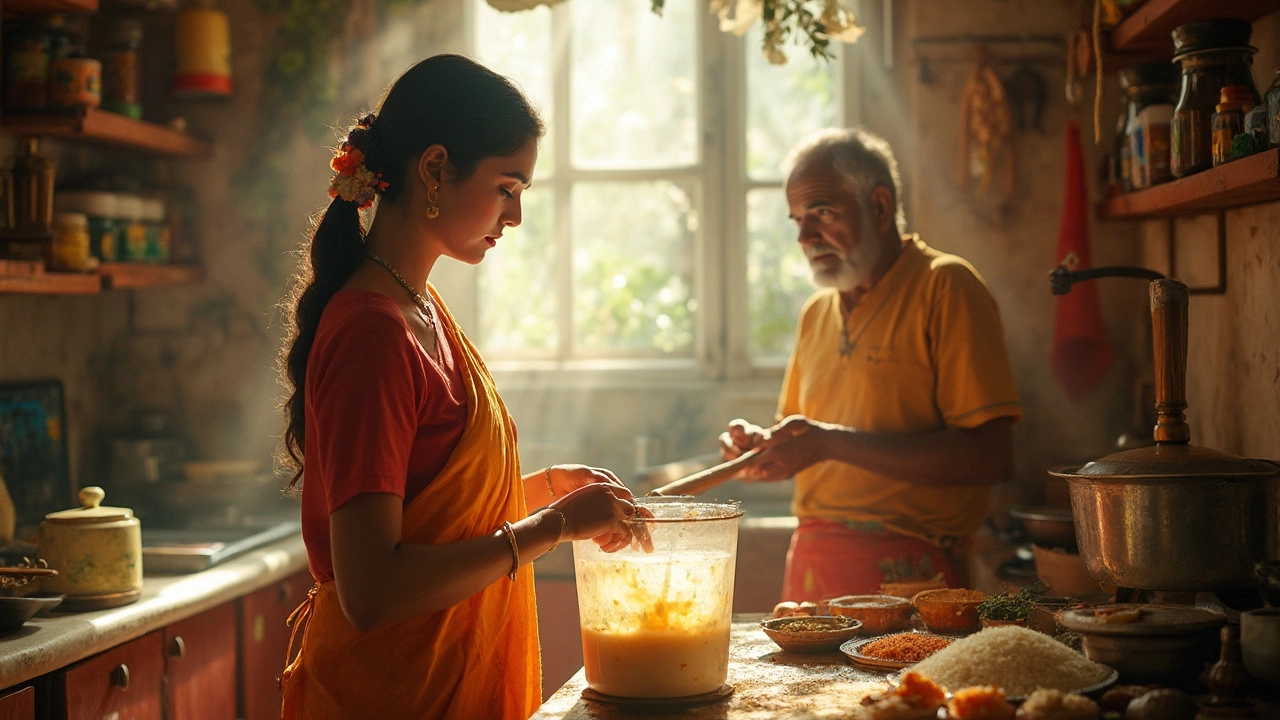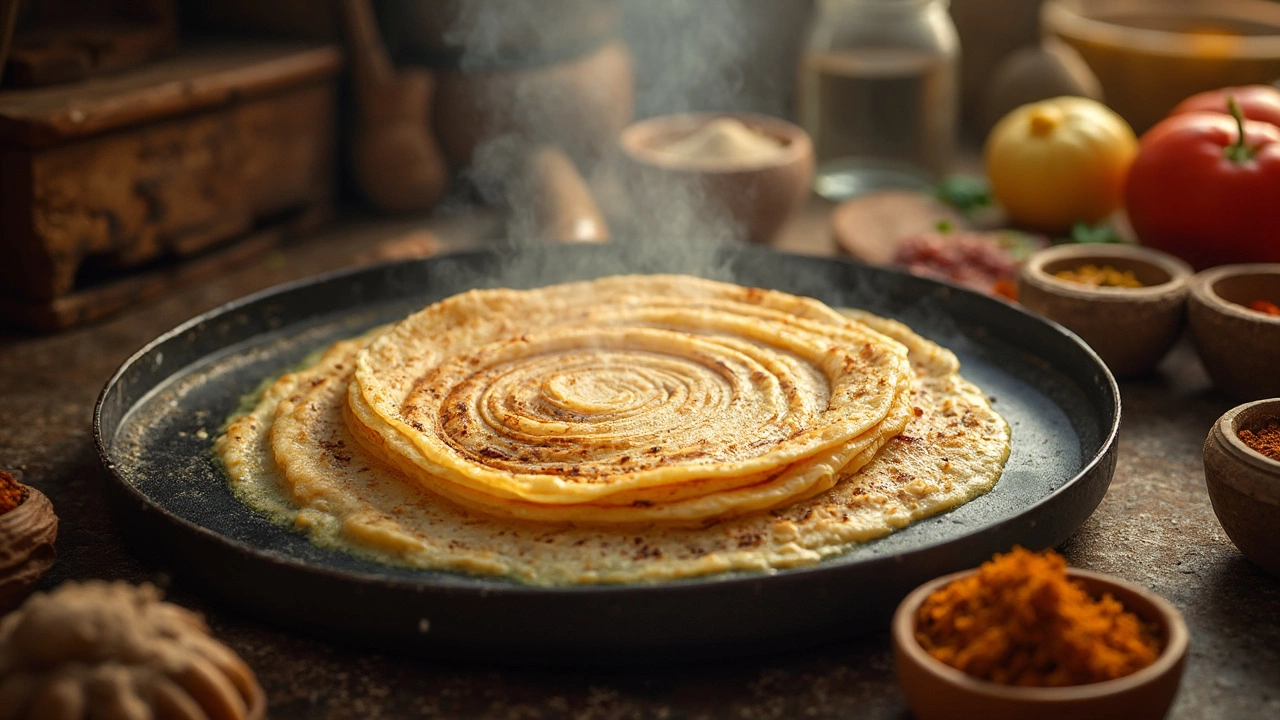Quick Dosa Batter Fermentation: Tips to Get Soft Dosas Fast
 Feb, 16 2025
Feb, 16 2025
Ever wanted a hot, crispy dosa for breakfast but found yourself stuck waiting ages for the batter to ferment? Let's dive right into a few tried-and-true methods to speed things up. Anyone who's made dosas knows that the fermentation process holds the secret to achieving that perfect blend of lightness and flavor. But this step can often take anywhere from 8 to 12 long hours. So, how can you cut down on this waiting time?
Firstly, consider the climate. Warmer environments naturally speed up the fermentation. If it's winter, or if you live in a cooler place, setting your bowl in a cozy nook near some warmth can make a big difference. Kitchens tend to have warm spots - maybe on top of a fridge or near a sunny window sill. Simple changes in where you place the batter can save you a lot of time.
- Understanding Fermentation Basics
- Climate and Ingredients Effect
- Alternative Fermentation Methods
- Practical Tips and Tricks
Understanding Fermentation Basics
Fermentation is where the magic happens when making a dosa. It's all about transforming a straightforward mix of rice and lentils into a deliciously bubbly and tangy batter ready for cooking. But how does this transformation occur? It mainly boils down to the activity of natural bacteria and yeast that thrive in your batter under the right conditions.
So, what's happening inside that bowl? When you soak and grind your rice and urad dal, you’re not just preparing ingredients but creating an environment ripe for microbial action. These tiny organisms feast on carbohydrates, producing carbon dioxide, which makes your batter rise and adds that signature tangy flavor.
Key Factors Affecting Fermentation
Several factors can impact how quickly and effectively your fermentation occurs. Let's break them down:
- Temperature: Warmer temperatures boost microbial activity, so try to maintain a warm environment around the batter. This could mean placing it in an oven with just the light on, or using a heating pad.
- Water Quality: It's a small detail but using filtered water can sometimes speed up the process, especially if your tap water is heavily chlorinated.
- Grinding: Grinding your ingredients to the right consistency is crucial. You're aiming for a smooth paste with a slight graininess that allows the microbes to flourish.
- Proportions: Stick to a 3:1 ratio of rice to dal for optimal fermentation. It's the sweet spot for getting a good rise and a silky batter.
The Role of Ingredients
The choice of ingredients also plays a significant role in quick batter fermentation. Both the type of rice and lentils can influence your results. Traditionally, short or medium-grain rice and whole urad dal work best. The bran present in whole urad dal contains natural fermenting agents that aid the process.
Fermentation Timing
Timing is everything. While letting the batter ferment overnight is ideal, you can often achieve quick results by adjusting these key factors. Remember, the ultimate test is in the batter's appearance and taste – it should bubble and emit a pleasant sour aroma.
Climate and Ingredients Effect
When it comes to ensuring your dosa batter ferments just right, the weather plays a crucial role. Warmer climates are naturally ideal for this process, as they help yeast and bacteria grow more quickly, resulting in that perfect rise. If you live in a colder place, you might need to improvise a little, like placing your batter in a warmer spot in your home.
Temperature Hacks
Try keeping the batter inside a microwave or oven that's turned off but with a light on. This trick creates a cozy environment to kickstart fermentation. Another nifty idea is placing the bowl over a pan with warm water—it works wonders, especially in winter!
Role of Ingredients
The ingredients in your batter can also impact how fast it ferments. While traditional recipes call for rice and urad dal, adding a handful of poha (flattened rice) or a teaspoon of fenugreek seeds can speed up the process. These elements act like natural boosters, helping the batter puff up in less time.
Don't forget to use fresh ingredients. Old, stale urad dal can really slow things down. Also, water quality matters—soft water is generally better as hard water can interfere with fermentation.
The Salt Factor
Adding salt can be a bit tricky. While it's important for flavor, adding it too early can hinder fermentation. Either skip it during the initial stage or add it midway, once you've noticed some activity in the batter.
Following these easy tips can lead to a noticeable difference in your batter's fermentation time, giving you soft dosas much quicker. And don't all these little tricks make a world of difference when you're in a hurry and all you want is a plate full of crispy dosas?

Alternative Fermentation Methods
If you've ever found yourself impatiently waiting for your dosa batter to ferment, you're not alone. Luckily, there are alternative methods to speed things up without compromising on taste. Let’s explore some options that can bring those soft dosas to your plate faster.
Use Baking Soda or Yeast
One of the quickest ways to accelerate fermentation is by using baking soda or yeast. These agents act as catalysts:
- Yeast: Dissolve a small pinch of yeast in warm water and add it to your batter. It kicks off the fermentation process almost immediately.
- Baking Soda: Add about a quarter teaspoon per cup of batter. It increases the batter's alkalinity, encouraging quicker fermentation.
Both of these methods are handy when you’re short on time, but be mindful of the quantity; too much can alter the taste.
Yogurt as a Natural Booster
Another practical method is to add a spoonful of yogurt to the batter. Yogurt contains active cultures that can give your dosa batter a much-needed boost. This is particularly useful if your batter is looking a bit sluggish on a cold day.
Microwave Method
Here’s a nifty trick: After mixing your batter, place it in a microwave-safe bowl and set it in the microwave with the power off. The residual heat helps maintain a warm environment, perfect for fermentation. Do not turn the microwave on with the batter inside, though!
Even More Tricks
By using a combination of these methods, you can achieve a faster fermentation process, ensuring those mouth-watering soft dosas are ready in time for your meal. Remember to always keep an eye on your batter, as over-fermentation can affect the texture and taste.
Practical Tips and Tricks
So, you've got your batter and you want to ensure you get the best out of it. Luckily, there are a few practical tips up my sleeve that could make a world of difference for those seeking the perfect soft dosas fast.
Use the Right Ingredients
First things first, the choice of ingredients plays a significant role in speeding up fermentation. Always use fresh, high-quality urad dal and rice. Old dal or rice can slow down the process and affect the dosa's texture. A ratio of 3 parts rice to 1 part urad dal is usually a good starting point.
Add Accelerators
For that quick boost in fermentation, add a handful of soaked fenugreek seeds to your mix. Fenugreek acts as a natural enhancer and can introduce more bacterial action. Also, a pinch of sugar can serve as quick food for the fermenting organisms, giving them a gentle push.
Optimize Your Environment
A warm environment is crucial for quick batter fermentation. If you're struggling with a cold kitchen, try using an oven. Preheat it to 40°C (104°F), turn it off, and place the covered batter inside. The retained warmth speeds up the process quite effectively.
Blend it Right
Finer batter equals better fermentation. While grinding the mixture, aim for a smooth paste. Blending for around 20-30 minutes on medium speed can provide that ideal texture. You should see tiny bubbles in the batter indicating active fermentation.
Consistency Matters
Consistency is key! Make sure your batter is thick yet pourable. If it's too runny, the fermentation might not produce the desired bubbles, leading to dense, flat dosas.
Try these tips and you're on your way to enjoying crispy, soft dosas without the frustrating wait. Happy cooking!